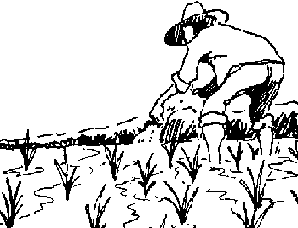Corbicula fluminea is a species of freshwater clam, an aquatic bivalve mollusk in family Corbiculidae.
This species is of originally mainly Asian origin and thus it is often commonly called Asian clam or Asiatic clam. In the aquarium and koi pond trade it is often call Golden Clam or Golden Freshwater Clam. In Southeast Asia it is known as the prosperity clam or good luck clam.
Native species clam originally occurs in Russia, Thailand, Philippines, China, Taiwan, Korea, Japan, but also in parts of Africa.
Native species clam originally occurs in Russia, Thailand, Philippines, China, Taiwan, Korea, Japan, but also in parts of Africa.
 |
| Clams (Agihis in Hiligaynon) |
Clams grow naturally in many rice paddies and rural people have traditionally harvested them. This was true until chemical use in rice paddies resulted in the elimination of these clams in many areas. Intentional culturing of clams simply adds one extra step to the traditional clam harvesting -the seeding of clams.
From work with farmers in Quirino province, it was found that:
· Clam culture in rice serves as a buffer against unforeseen crop losses due to flooding or diseases like tungro.
· Clam production serves as a source of additional income (in 1 hectare paddy the average yield was 226 kg marketable clams valued at P1,800/ha.)
· In addition to extra income, the clams serve as a source of protein and minerals for the farmer's family.
1. 20-25 days after planting, increase the irrigation water in the paddies to the maximum tolerable depth proportionate to the rice plant (approximately 5 cm depth). If the crop needs weeding, the rotary weeder can be used before irrigation.
3. On the third day, drain the water and replace it with fresh irrigation water to the depth mentioned above.
4. Evenly broadcast baby clams along the rice furrows. Seeding should be done in every other furrow.
5. Harvest the clams as soon as they reach the desired marketable size (size of the new P50 coin) or just before harvesting the rice.
 |
| Increase the irrigation water in the paddies |
2. Let the water stand for 2 days to soften the soil and to neutralize sold toxicity or pesticide residues.
 |
| Let the water stand for 2 days |
 |
| Drain the water and replace it with fresh irrigation water |
 |
| Evenly broadcast baby |
 |
| Harvest the clams |
Note:
· Avoid using chemical insecticides; as a substitute, use botanicals.
· Don't introduce carp into the paddies seeded with clams. Carp eat clams.
· Faster growth of clams is attained when fields are fertilized with organic materials.
· Medium- to long-maturing rice varieties should be used in clam-rice culture. This allows the clams to stay longer in the paddy field.
· Rice-clam system is best suited to areas where there is a continuous supply of water.
· Don't introduce carp into the paddies seeded with clams. Carp eat clams.
· Faster growth of clams is attained when fields are fertilized with organic materials.
· Medium- to long-maturing rice varieties should be used in clam-rice culture. This allows the clams to stay longer in the paddy field.
· Rice-clam system is best suited to areas where there is a continuous supply of water.
 |
| Clams Recipe |
No comments:
Post a Comment